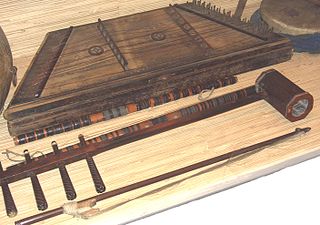The datong (大筒) is a bowed string instrument in the huqin family, and is used as an accompanying instrument in the huaguxi opera tradition of Hunan, China. Referring to this role, the instrument is also referred to huagu datong (花鼓大筒).

String instruments, stringed instruments, or chordophones are musical instruments that produce sound from vibrating strings when the performer plays or sounds the strings in some manner.

Huqin is a family of bowed string instruments, more specifically, a spike fiddle popularly used in Chinese music. The instruments consist of a round, hexagonal, or octagonal sound box at the bottom with a neck attached that protrudes upwards. They also usually have two strings, and their soundboxes are typically covered with either snakeskin or thin wood. Huqin instruments usually have two tuning pegs, one peg for each string. The pegs are attached horizontally through holes drilled in the instrument's neck. Most huqin have the bow hair pass in between the strings. Exceptions to having two strings and pegs include variations of huqin with three, four, and sometimes even more than five. These include the zhuihu, a three stringed huqin, the sihu, a huqin of Mongolian origin, and the sanhu, a lesser-known three-stringed variation.
Traditionally the datong was constructed with a bamboo body, and covered on the playing end with snakeskin. Its neck is made of hardwood. Silk strings were used in the past, but most contemporary players use steel strings.

The bamboos are evergreen perennial flowering plants in the subfamily Bambusoideae of the grass family Poaceae. The word "bamboo" comes from the Kannada term bambu (ಬಂಬು), which was introduced to English through Indonesian and Malay.
Snakeskin may either refer to the skin of a live snake, the shed skin of a snake after molting, or to a type of leather that is made from the hide of a dead snake.

Hardwood is wood from dicot trees. These are usually found in broad-leaved temperate and tropical forests. In temperate and boreal latitudes they are mostly deciduous, but in tropics and subtropics mostly evergreen. Hardwood contrasts with softwood.
The datong is held upright on the lap when played.
The datong should not be confused with the datongxian (also called daguangxian), another type of Chinese fiddle that is used in Taiwan and Fujian.
The daguangxian is a Chinese bowed two-stringed musical instrument in the huqin family of instruments, held on the lap and played upright. It is used primarily in Taiwan and Fujian, among the Hakka and Min Nan peoples.

Taiwan, officially the Republic of China (ROC), is a state in East Asia. Neighbouring states include the People's Republic of China (PRC) to the west, Japan to the northeast, and the Philippines to the south. Taiwan is the most populous state and largest economy that is not a member of the United Nations (UN).

Fujian, is a province on the southeast coast of mainland China. Fujian is bordered by Zhejiang to the north, Jiangxi to the west, Guangdong to the south, and the Taiwan Strait to the east. The name Fujian came from the combination of Fuzhou and Jianzhou, two cities in Fujian, during the Tang dynasty. While its population is chiefly of Han origin, it is one of the most culturally and linguistically diverse provinces in China.
This page is based on this
Wikipedia article Text is available under the
CC BY-SA 4.0 license; additional terms may apply.
Images, videos and audio are available under their respective licenses.
The Great Unity is a Chinese utopian vision of the world in which everyone and everything is at peace. It is found in classical Chinese philosophy which has been invoked many times in the modern history of China.

The pipa is a four-stringed Chinese musical instrument, belonging to the plucked category of instruments. Sometimes called the Chinese lute, the instrument has a pear-shaped wooden body with a varying number of frets ranging from 12 to 26. Another Chinese four-string plucked lute is the liuqin, which looks like a smaller version of the pipa. The pear-shaped instrument may have existed in China as early as the Han dynasty, and although historically the term pipa was once used to refer to a variety of plucked chordophones, its usage since the Song dynasty refers exclusively to the pear-shaped instrument.
The erhu is a two-stringed bowed musical instrument, more specifically a spike fiddle, which may also be called a Southern Fiddle, and sometimes known in the Western world as the Chinese violin or a Chinese two-stringed fiddle.

Datong is a prefecture-level city in northern Shanxi Province in the People's Republic of China. It is located in the Datong Basin at an elevation of 1,040 metres (3,410 ft) and borders Inner Mongolia to the north and west and Hebei to the east. It had a population of 3,318,057 during the 2010 census, of whom 1,629,035 lived in the built-up area made of the three urban districts of Chengqu, Kuangqu and Nanjiao.
Datong (大同市) is a prefecture-level city in Shanxi province, China.

Datong District or Tatung is a district of Taipei City, Taiwan. It is located between the Taipei Metro Red Line and eastern shore of the Tamsui River, and between Civic Boulevard and the Sun Yat-sen Freeway. The southern part of this area used to be the site of Twatutia, one of the first settlements in what is now Taipei and for a time the area's commercial center.

The term Chinese orchestra is most commonly used to refer to the modern Chinese orchestra that is found in China and various overseas Chinese communities. This modern Chinese orchestra first developed out of Jiangnan sizhu ensemble in the 1920s into a form that is based on the structure and principles of a Western symphony orchestra but using Chinese instruments. The orchestra is divided into four sections - wind, plucked strings, bow strings, and percussion, and usually performs modernized traditional music called guoyue. The orchestra may be referred to as Minzu Yuetuan or Minzu Yuedui in mainland China, Zhongyuetuan in Hong Kong, Huayuetuan in South East Asia, or Guoyuetuan in Taiwan, all meaning Chinese orchestra.

The sihu is a Chinese bowed string instrument with four strings. It is a member of the huqin family of instruments.
The dahu is a large bowed string instrument from China. It has a large soundbox covered on one end with python skin. Like most other members of the huqin family of instruments, it has two strings and is held vertically. The instrument is generally pitched one octave below the erhu, and is considerably larger than the erhu. Its name derives from the Chinese word for "large" (dà), and the word hú. Its bridge is often placed somewhat above the center of the snakeskin to avoid stretching the skin.
The erxian is a Chinese bowed string instrument in the huqin family of instruments. It has two strings and is used primarily in Cantonese music, most often in "hard string" chamber ensembles. In the 1920s, following the development of the gaohu, the erxian experienced a decline and since the late 20th century has been little used outside the tradition of Cantonese opera.

The dihu is a large bowed string instrument from China. It has a large soundbox covered on one end with snakeskin. Like most other members of the huqin family of instruments, it has two strings and is held vertically. The instrument's name derives from "dī," meaning "low," and "hú".
The mangtong is a Chinese end-blown free reed wind instrument. It is used primarily by the Miao and Dong ethnic groups of the southern Chinese provinces of Guizhou and Guangxi, although it is sometimes used in contemporary Chinese compositions for the traditional instrument orchestra.

Traditional Korean musical instruments comprise a wide range of string, wind, and percussion instruments. Many traditional Korean musical instruments derive from Chinese musical instruments.
Traditional Japanese musical instruments are musical instruments used in the traditional and folk music of Japan. They comprise a range of string, wind, and percussion instruments.

Datong Yungang Airport is an airport serving the city of Datong in Shanxi Province, China. It is located north of the town of Beijiazao in Datong County, 15.2 kilometers from the city center.
Jiangnan sizhu is a style of traditional Chinese instrumental music from the Jiangnan region of China.

Yunzhou District is a district of the city of Datong, Shanxi. It was formerly known as Datong County until 9 February 2018 in a State Council-approved reshuffle of Datong's administrative divisions.















